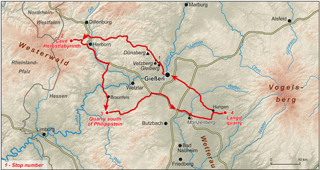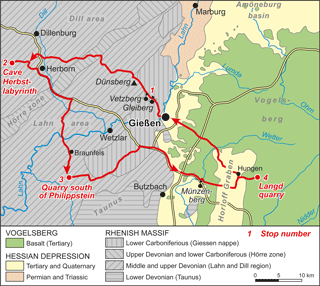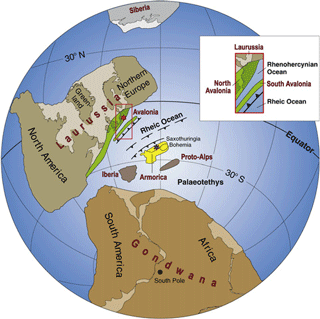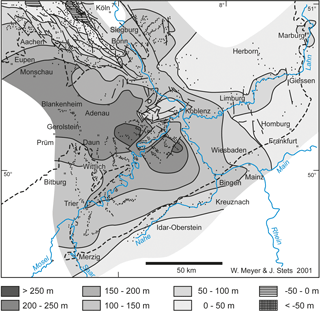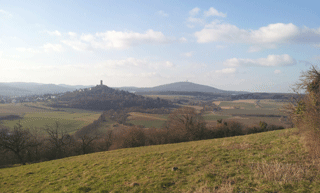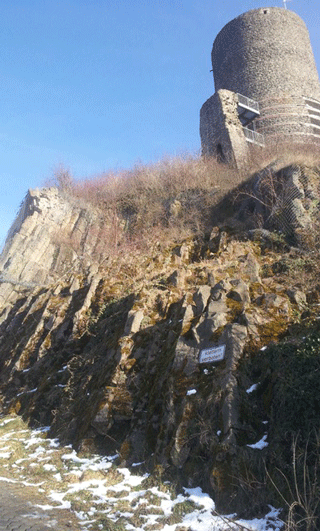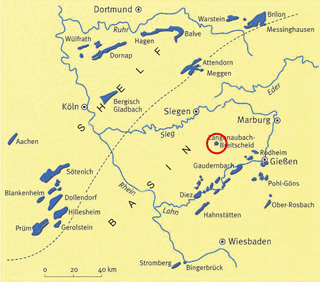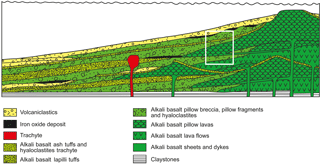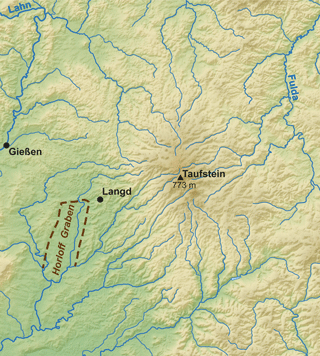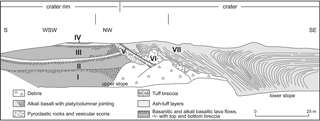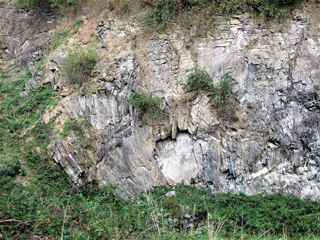Field Trip A (23 September 2018): geology and geomorphology of Giessen and its surrounding areas
This field trip is intended to present an introduction to the geological and geomorphological evolution of Giessen and its surrounding areas (Fig. 1). The conference location of Giessen is located at the intersection of three major geological and morphological units: the Rheinisches Schiefergebirge (Rhenish Massif) to the west, the Hessische Senke (Hessian Depression) to the north and south and the Vogelsberg volcanic field to the east (Fig. 2).
The rocks of the Rheinisches Schiefergebirge (Rhenish Massif) were formed during Paleozoic times, in the context of the Variscan orogeny. Dominant rock types include graywacke, slate, quartzite, and limestone, as well as mafic and felsic volcanics and their related pyroclastics. The area north and south of Giessen is dominated by the Hessische Senke (Hessian Depression), a north–south-trending subsidence area with several individual deposit segments. Due to Cenozoic tectonic activity, the Hessian Depression can be regarded as a connecting segment between the prominent Upper Rhine Graben and the smaller graben structures of northern Germany, and this is also documented by less consolidated Tertiary and Quaternary sediments. Long-lasting subsidence of the Hessian Depression, however, is indicated by the presence of Permian and Mesozoic sedimentary rocks. Rotliegend rocks are present towards the southwest rim of the Vogelsberg volcanic field and the Hanau-Seligenstädter Senke. Minor occurrences of Zechstein rocks are exposed along the Lahn valley between Giessen and Marburg. Mesozoic strata are dominated by Buntsandstein and are widespread in the Marburg area, with Muschelkalk and Keuper rocks being restricted to small erosional remnants in tectonic graben structures. The area to the east of Giessen is dominated by the Miocene Vogelsberg volcanic field, where an estimated area of 2500 km2 is covered by volcanic rocks of varying thickness, the Vogelsberg thus being the largest volcanic field of central Europe. The field trip provides an introduction to the geology, earth history and geomorphological characteristics of Giessen and its surrounding areas. We will therefore encounter rocks that formed in distinct geodynamic environments and within a timespan of roughly 400 Ma (Devonian to present).
Die Exkursion bietet mit ihrem Routenverlauf und den ausgewählten Aufschlüssen eine Einführung in die vielgestaltige geologische und geomorphologische Entwicklungsgeschichte des Tagungsortes Gießen und seiner näheren Umgebung. Die Stadt Gießen liegt am Schnittpunkt dreier bedeutender geologischer und geomorphologischer Einheiten: im Westen das jungkänozoisch gehobene Rheinische Schiefergebirge, im Osten das ausgedehnte miozäne Vulkanfeld des Vogelsberges und dazwischen die N-S verlaufende Hessische Senke mit ihren mesozoischen und känozoischen Sedimentfüllungen.
Die Gesteine des Rheinischen Schiefergebirges wurden im Paläozoikum gebildet und ihre Entstehung steht im engen Zusammenhang mit der Variszischen Orogenese. Die dominierenden Gesteinsarten umfassen, je nach Ablagerungsraum und plattentektonischer Position, Grauwacken, Tonschiefer, Quarzite, biogene Kalksteine sowie mafische und felsische Vulkanite mit ihren korrelaten Pyroklastika. Die heutige morphologische Ausgestaltung des Rheinischen Schiefergebirges ist zu einem großen Teil auf die quartärzeitliche Hebung zurückzuführen. Die Gebiete nördlich und südlich von Gießen werden von der Hessischen Senke dominiert, einem N-S verlaufenden Subsidenzgebiet mit mehreren individuellen Ablagerungsräumen. Der lang anhaltende Subsidenzcharakter wird belegt durch die Anwesenheit permischer und mesozoischer Sedimente. Gesteine des Rotliegend finden sich vereinzelt am SW-Rand des Vogelsbergs und in der Hanau-Seligenstädter Senke. Relikte von Zechstein-zeitlichen Gesteinen sind vereinzelt an den Lahnhängen zwischen Marburg und Gießen aufgeschlossen. Bei den mesozoischen Gesteinen dominieren die klastischen Abfolgen des Buntsandstein, die große Gebiete im Raum Marburg in charakteristischer Weise prägen. Im Känozoikum kam es dann zur Ausbildung des Europäischen Grabensystems, das vom Rhonegraben bis weit in die Nordsee reicht. In Mittelhessen führte dies zu einer Wiederauflebung der Subsidenz-Tektonik und zur Anlage mehrerer individueller Ablagerungsräume mit gering verfestigten tertiären und quartären Sedimenten. Die Hessische Senke kann somit als Bindeglied zwischen dem großen Oberrheingraben im Süden und den kleineren Grabenstrukturen im nördlichen Deutschland angesehen werden. Das Gebiet östlich von Gießen wird durch die miozänen Vulkanite des Vogelsbergs eindrucksvoll dominiert. Trotz intensiver Erosion im Neogen und Quartär bedecken die Vulkanite heute noch eine Fläche von etwa 2500 km2 und machen damit den Vogelsberg zum größten zusammenhängenden Vulkanfeld Mitteleuropas. Die Exkursion vermittelt somit einen Einblick in den vielgestaltigen Aufbau und die geomorphologischen Charakteristika des Tagungsortes Gießen und seiner näheren Umgebung. Im Verlauf der Exkursion werden Gesteine angetroffen, die in ganz unterschiedlichen geodynamischen Situationen entstanden sind und einen erdgeschichtlichen Zeitraum von etwa 400 Ma (Devon bis Rezent) umfassen.






